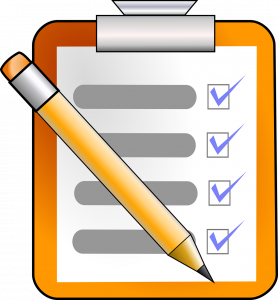Chapter 7: Making Your Own Argument
Building an Initial Two-Storey Thesis for Your Own Argument
Now that you have gathered evidence, you have built the foundation for the first storey of your complex argument. That first storey will look a lot like the first storey you built for your close readings: you are pointing to the best one or two pieces of evidence on which you are going to base your argument.
Obviously, you can’t discuss everything in your central document, so you need narrow your focus, like you did with your close readings, to the two best pieces of evidence. You can do this by looking at the list of evidence you gathered when close reading your central document and asking:
- Which pieces of evidence are the most interesting?
- Which pieces of evidence are the most important?
- Do your pieces of evidence address both the content and the medium of your central document?
- Are there two pieces of evidence that are similar and might combine to make an effective argument?
- Does each piece of evidence add something different to your potential argument? (You do not want two pieces of evidence repeating the same idea.)
For example, look through your list of evidence from Occupy Wall St.’s Facebook page. After thinking through all of the questions above, you may chose to focus on the comments on one post and from there, focus in on the repetition of commenters linking to their own local projects as the first piece of evidence and the repetition of commenters mentioning their local cities in their posts. Therefore, your first storey might look something like this:
Occupy Wall Street’s Facebook page showcases that users of the page have a difficult and often frustrating time linking global events to local events and concerns that are more personal to them. This is demonstrated by the comments under the post “From #Ferguson to #Gaza #BLM,” wherein discussion of the event leads to participants calling each other names like “idiots” and angry confusion over how the Black Lives Matter is related to the Middle East (ex. The post “What the hell does BLM have to do with geopolitics in the Middle East?”).
As you can see, not only do we state our two selected pieces of evidence, we also identify the central document (The Occupy Wall Street Facebook page) and the specific aspects of the central document we will be examining (a post and its comments thread).
Now we are ready to move onto the second storey. This is where we begin making your argument about our central document. We want to remain focused just on our central document for now. For example, our second storey, using the example from the Occupy Wall Street Facebook page, would be about only the specific page, or perhaps Facebook groups and pages used for protest movements, but not Facebook as a whole. Remember too that an argument is a statement that can be agreed or disagreed with. Therefore, look at your two pieces of evidence and ask:
- What is the significance of the evidence that you have chosen?
- What argument about the specific document can you make based on the evidence you have chosen? (Remember to stay focused at this point and not expand beyond that central document.)
- In what ways do the pieces of evidence overlap? What argument might be derived from that overlap?
- What are the benefits for the user/reader arise when interacting with your central document and how do those benefits relate to the evidence you’ve chosen?
- What problems for the user/reader arise when interacting with your central document and how do those problems relate to the evidence you’ve chosen?
As you move into your second storey and begin making your argument, answering these questions will help you connect your argument to the evidence you’ve chosen.

Do not be too precise in drafting your thesis at this point. Try to make it specific and complex but don’t limit yourself by thinking that you have to get it exactly right at this stage. You will be doing more research and revising, so your thesis will change and sharpen over the process of writing your essay. At this stage, aim for one or two sentences that make an argument about your central document using the evidence you’ve selected.

